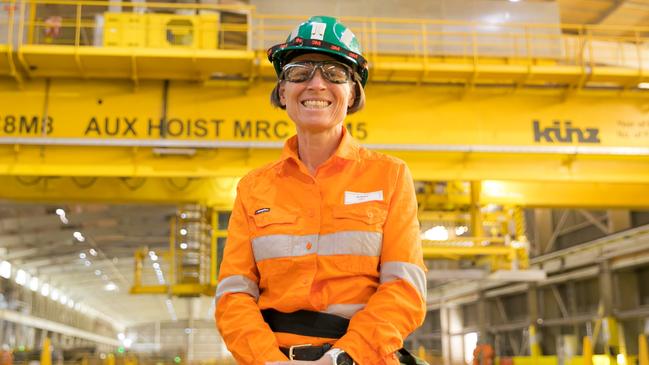The Olympic Dam copper and gold mine has produced its best results since BHP bought it
The Olympic Dam mine in South Australia’s Far North has had a bumper year, producing its best results since BHP bought it in 2005.
The Olympic Dam mine in South Australia’s Far North has delivered its best production results since BHP bought the asset in 2005, including record gold output worth more than $230m.
The copper, gold and uranium mine increased its copper production by 20 per cent to 205,000, at the top end of BHP’s guidance, and its gold production hit a record 146,000 ounces.
The company said the strong results reflected improved smelter stability and strong underground mine performance.

The $130m, five-year upgrade of the refinery at the mine hit a major milestone in May, with the commissioning of a new, 95-tonne electro-refinery crane.
The crane was a key element of the upgrade works that began with engineering plans in 2016 and started construction in 2018, creating 130 jobs during construction.
A $500 million smelter maintenance campaign, which was announced late last year, is scheduled to start before the end of this calendar year, and is expected to require a peak workforce of 1500 people, in addition to the mine’s regular workforce of 4000.
The maintenance campaign will lower production to 140,000-170,000 tonnes of copper for the current financial year.
Olympic Dam’s fortunes have ebbed and flowed since it was bought by BHP, with the $30bn plan to turn it into a huge one pit mine shelved in 2012, and a more modest $3.7bn brownfields expansion plan shelved in October last year.

That project would have increased production from the current capacity of 200,000 tonnes of copper per year to as much as 300,000.
The company appointed a new leader to the asset in February, with Dr Jennifer Purdie taking on the role previously filled by Laura Tyler, who was promoted to BHP chief technical officer.
Olympic Dam made a full-year loss before interest and tax of $US79m ($104m) in the 2020 financial year, on revenues of $US1.463bn, up from the previous year’s loss of $US58m.
Across BHP more broadly, the company hit new production records at its Pilbara operations as the price of iron ore surged in the first half of the year.
The mining giant exported 283.9 million tonnes for the full financial year, marginally above the 283.3 million tonnes from the previous year.
BHP boss Mike Henry said the average received price for the second half was $US158.15 a tonne, up 52 per cent compared to the first half of the year.
“We achieved production records at our Western Australia iron ore operations and the Goonyella Riverside metallurgical coal mine in Queensland. We maintained all-time high concentrator throughput at our Escondida copper mine in Chile,” he said.
BHP had said it expected to produce 276 to 286 million tonnes of iron ore from its Pilbara mines last financial year, upgrading the guidance in April to suggest it would fall in the upper end of the range.
BHP says it expects production of 278 to 288 million tonnes in the current financial year, as it ramps up its newly opened South Flank mine – an 80 million tonne a year hub that is also expected to eventually lift its average shipment grades from 61 per cent to 62 per cent iron, and vastly improve the proportion of valuable lump product its sells into the market.
BHP’s Queensland coking coal operations produced 21.1 million tonnes for the June quarter, and 72.5 million tonnes for the year, in line with the previous financial year.
Average realised prices for the full year were sharply down, however, as China’s bans on Australian coal hit the market prices for its products. BHP sold its coking coal for an average $US106.64 a tonne last financial year, down from $US130.97 the previous year.
BHP shares were trading 2 per cent lower at $49.47 on Tuesday.


To join the conversation, please log in. Don't have an account? Register
Join the conversation, you are commenting as Logout